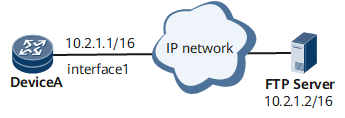Example for Outputting Information to the FTP Server
Information of specified modules and severities can be output to the FTP Server. By checking the information, maintenance engineers can learn the operation of the device and locate the fault occurring on the device.
Networking Requirements
Information can be saved in the form of files on the device. When faults occur on the device, information can be output from the information file and used for fault location. As shown in Figure 1, logs can be output to the information files of Device A. Storing excessive information files consumes a large number of memory resources. Generally, these files can be transmitted to an FTP server for unified maintenance. Maintenance engineers can query logs on the FTP server to learn the operation of Device A and locate the fault on Device A.

In this example, logs are output to an information file.

Interfaces 1 in this example are GE 0/1/0.
Configuration Roadmap
The configuration roadmap is as follows:
Enable the information management function.
Configure the information output channel.
Configure rules for outputting information.
Send information files to the FTP server.
Data Preparation
To complete the configuration, you need the following data:
IP address of each interface and routing protocol
Information channel number
Module and severity of the information to be output
IP address of the FTP server, and the user name and password for logging in to the FTP server
Procedure
- Configure a routing protocol to allow the router and FTP server to be reachable.
- Configure the IP address of the FTP server, and the user name and password for logging in to the FTP server.
- Configure the information output channel.
# Enable the information management function.
[~DeviceA] info-center enable
- Configure the channel through which information is output.
# Configure the channel through which information is output to the information file.
[*DeviceA] info-center logfile channel channel8
- Configure rules for outputting information.
# Output the information of warning or higher levels generated by the IM module through a channel.
[*DeviceA] info-center source im channel channel8 log level warning [*DeviceA] commit [~DeviceA] quit
- Transmit information files to the FTP server.
# Switch to the path of the information file.
<~A> cd cfcard:
# Log in to the FTP server.
<DeviceA> ftp 10.2.1.2 Trying to connect... Press CTRL+K to abort Connected to the server 220 FTP service ready. User(ftp 10.1.1.1:(none)):huawei 331 Password required for huawei Password: 230 User logged in.# Transmit information files to the FTP server.
[*ftp] put log_17_20110504041811.log [*ftp] quit
- Verify the configuration.
# Check the channel information carried in the output information.
<DeviceA> display info-center Information Center:enabled Log host: 10.0.0.1, channel number 2, channel name loghost, language English , host facility local7 Console: channel number : 0, channel name : console Monitor: channel number : 1, channel name : monitor SNMP Agent: channel number : 5, channel name : snmpagent Log buffer: enabled,max buffer size 10240, current buffer size 512, current messages 10, channel number : 4, channel name : logbuffer dropped messages 0, overwritten messages 0 Trap buffer: enabled,max buffer size 1024, current buffer size 256, current messages 3, channel number:3, channel name:trapbuffer dropped messages 0, overwritten messages 0 logfile: channel number : 8, channel name : channel8, language : English Information timestamp setting: log - date, trap - date, debug - date millisecond# Check the information files received on the FTP server.
